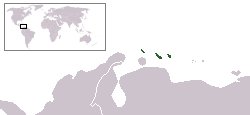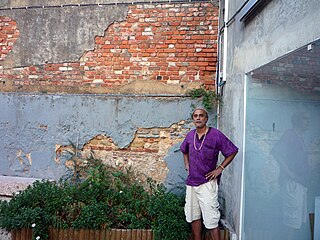
Papiamento or Papiamentu is a Portuguese-based creole language spoken in the Dutch Caribbean. It is the most widely spoken language on the Caribbean ABC islands, with official status in Aruba and Curaçao. Papiamento is also a recognised language in the Dutch public bodies of Bonaire, Sint-Eustatius and Saba.
Sergio Frusoni was a poet and promoter of the Cape Verdean Creole language.
Cape Verdean Creole is a Portuguese-based creole language spoken on the islands of Cape Verde. It is also called Kriolu or Kriol by its native speakers. It is the native creole language of virtually all Cape Verdeans and is used as a second language by the Cape Verdean diaspora.
Cape Verdean Americans are an ethnic group of Americans whose ancestors were Cape Verdean. In 2010, the American Community Survey stated that there were 95,003 Americans living in the US with Cape Verdean ancestors.
Santiago Creole is the name given to the Cape Verdean Creole spoken mainly on Santiago Island of Cape Verde. It belongs to the Sotavento Creoles branch of Creole.

Cape Verdean Portuguese is the variety of Portuguese spoken in Cape Verde.
São Vicente Creole is the name given to the variant of Cape Verdean Creole spoken mainly in the São Vicente Island of Cape Verde. It belongs to the Barlavento Creoles branch. This form of the Cape Verdean Creole has about 80,000 to 100,000 speakers primarily in the São Vicente island, but also in a large segment of the Cape Verdean diaspora population. It is the second most widely spoken Cape Verdean creole. It has produced literature from a lot of writers and musicians including Sergio Frusoni and many more.
Brava Creole is the name given to the variant of Cape Verdean Creole spoken mainly in the Brava Island of Cape Verde. It belongs to the Sotavento Creoles branch. The speakers of this form of Capeverdean Creole are 8,000. One of the least spoken being seventh place and one of the firsts to have written literature, in which Eugénio Tavares wrote some of his poems.
Santo Antão Creole, is the name given to the variant of Cape Verdean Creole spoken mainly in the Santo Antão Island of Cape Verde. It belongs to the Barlavento Creoles branch. It is ranked third of nine in the number of speakers and it is before Fogo and after the neighbouring São Vicente.
Maio Creole is the name given to the variant of Cape Verdean Creole spoken mainly in the Maio Island of Cape Verde. It belongs to the Sotavento Creoles branch. It numbers the entire island population which includes a small part which also speaks Portuguese, in 2005, the percentage was 1.36%.
Boa Vista Creole is the name given to the variant of Cape Verdean Creole spoken mainly in the Boa Vista Island of Cape Verde. It belongs to the Barlavento Creoles branch. This form of Cape Verdean Creole was spoken by 5,000 ppl. in 2007 and is the least spoken form of Creole in the language. Literature is rarely recorded but one of the speakers who was born on the island is Germano Almeida.
Sal Creole is the name given to the variant of Cape Verdean Creole spoken mainly in the island of Sal of Cape Verde. It belongs to the Barlavento Creoles branch. The speakers of this form of Cape Verdean Creole are 15,000.
São Nicolau Creole is the variant of Cape Verdean Creole spoken mainly in the São Nicolau Island of Cape Verde. It belongs to the Barlavento Creoles branch. The speakers of this form of Cape Verdean Creole are 15,000 and it is the fifth most spoken form of Creole in the language. Literature is rarely recorded but the form of the Capeverdean Creole has been recorded in music.

Sambal or Sambali is a Sambalic language spoken primarily in the Zambal municipalities of Santa Cruz, Candelaria, Masinloc, Palauig, and Iba, and in the Pangasinense municipality of Infanta in the Philippines; speakers can also be found in Panitian, Quezon, Palawan and Barangay Mandaragat or Buncag of Puerto Princesa. The speakers of the language are decreasing due to the fact that many of the speakers are shifting to Tagalog.
The Alfabeto Unificado para a Escrita do Caboverdiano, commonly known as ALUPEC, is the alphabet that was officially recognized by the Cape Verdean government to write Cape Verdean Creole.

Cape Verde or Cabo Verde, officially the Republic of Cabo Verde, is an archipelago and island country in the central Atlantic Ocean, consisting of ten volcanic islands with a combined land area of about 4,033 square kilometres (1,557 sq mi). These islands lie between 600 and 850 kilometres west of Cap-Vert, the westernmost point of continental Africa. The Cape Verde islands form part of the Macaronesia ecoregion, along with the Azores, the Canary Islands, Madeira, and the Savage Isles.
Mavea is an Oceanic language spoken on Mavea Island in Vanuatu, off the eastern coast of Espiritu Santo. It belongs to the North–Central Vanuatu linkage of Southern Oceanic. The total population of the island is approximately 172, with only 34 fluent speakers of the Mavea language reported in 2008.

The history of the cinema of Cape Verde dates back to the arrival of filmmakers in the early twentieth century. The first picture house was established in Mindelo around 1922, called Eden Park.

Fernando Hamilton Barbosa Elias, also known as Mito or Mito Elias is a Cape Verdean artist, visual artist and a poet.

Colá is a musical genre of Cape Verdean music





